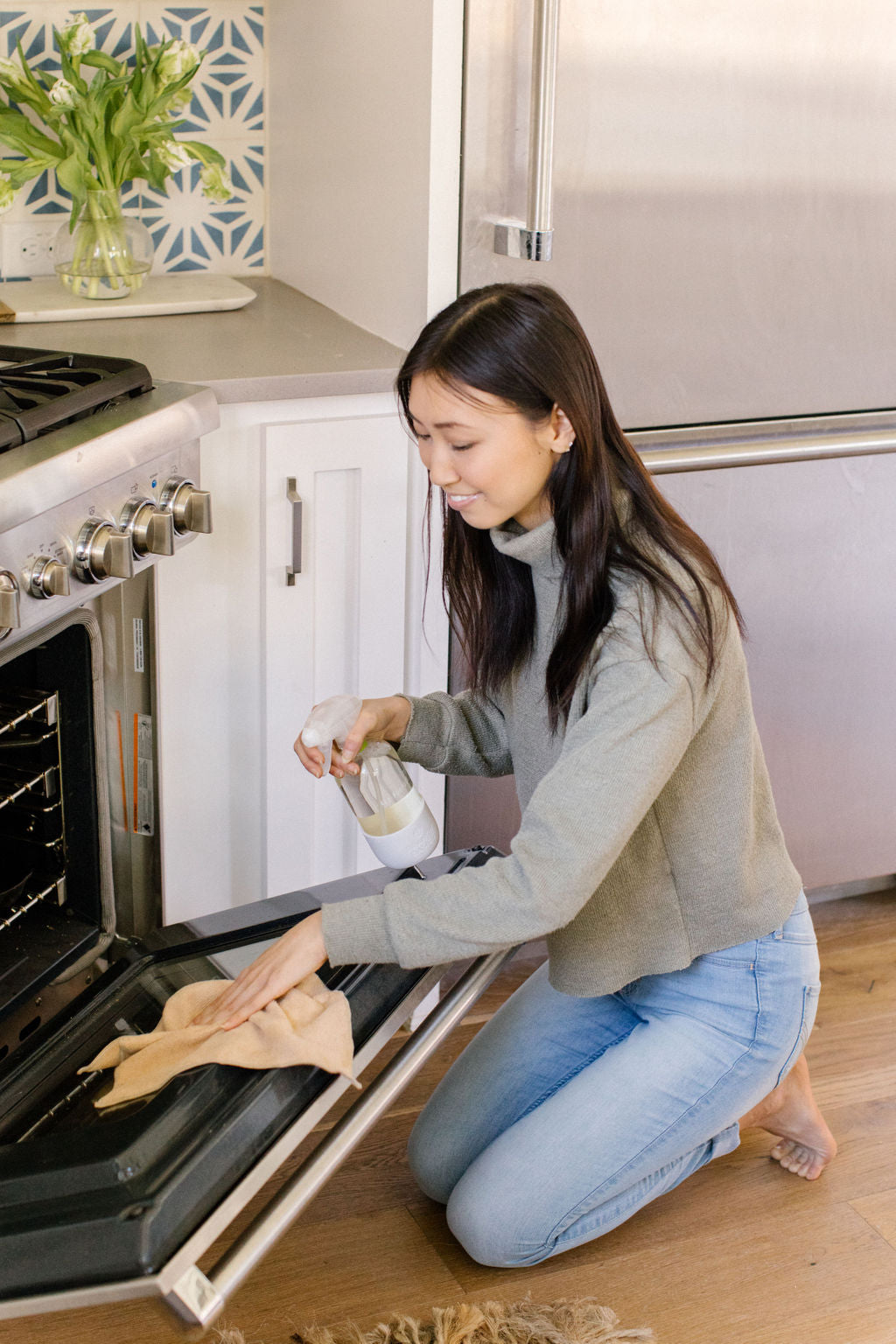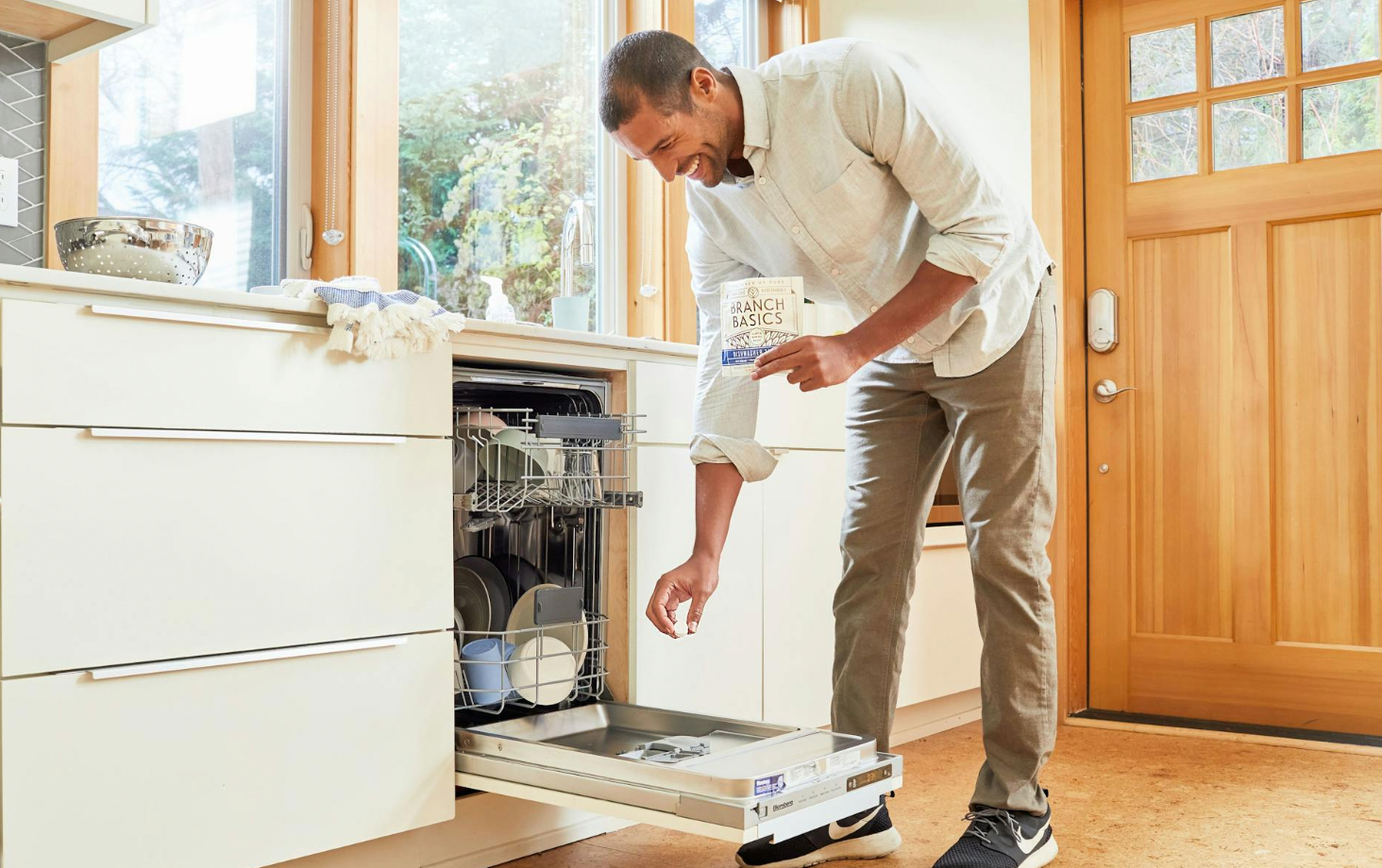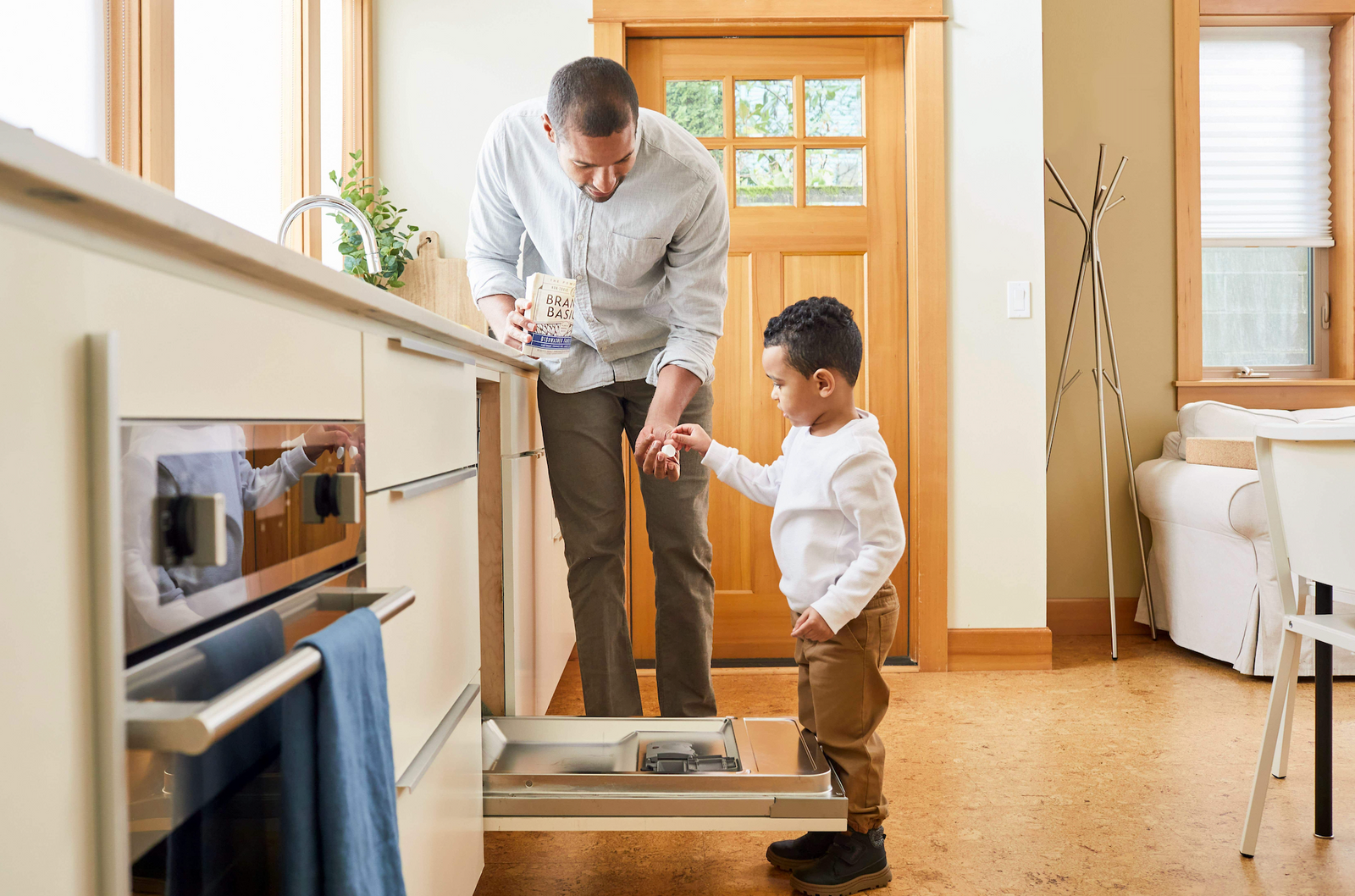Safe Oven Cleaning: How to Clean Ovens & Stove Tops Naturally

Do you put off cleaning your oven because you hate the smell of toxic oven cleaner?
Or maybe you aren’t comfortable using your oven’s self-clean function that wastes all that energy, sets off your smoke detectors, and creates its own set of harmful fumes.
We understand the dilemma! Yet, keeping ovens and stove tops clean is super important to prevent fires, protect indoor air quality, and make cooking easier.
Fortunately, there is a simple way to naturally clean your oven and stove top without toxic cleaners or wasting energy. In this article, we’ll share how you can use Branch Basics and other safe and natural products to get your oven and stove tops squeaky clean, naturally.
Why is it Important to Use Human-Safe Cleaning Products?
We’ve covered this at length in other articles, podcasts, and online courses, but chemical-based cleaning products contain a toxic soup of harmful ingredients.
Several studies have shown the shocking health impacts of using common chemical-based cleaners—including laundry products, including (but not limited to):
- Poisoning leading to hospitalization and/or death
- Blindness
- Cancer
- Lung diseases such as asthma and obstructive respiratory illnesses
- Skin ailments
- Chemical burns
- Developmental disorders
- Increased rate of miscarriage and fetal death
- Congenital malformations
- Fertility issues
- Endocrine disruption
- Liver and kidney damage
- Behavioral problems
- Headaches/migraines
- Microbiome disruption
- Immune suppression
- Obesity
- And much, much more
You may be thinking: “I use mostly natural products, but with certain things (like my oven), I need the synthetic chemicals to get it clean.”
We understand why people feel this way. After all, most of us are taught that chemicals equal cleanliness (and that we needed to evacuate the house when mom cleaned the oven).
However, the idea that you need harsh chemicals to clean your oven, stove top, or any part of your home is a complete myth.
Plus, the chemicals in oven cleaners – such as caustic soda (aka potassium hydroxide), sodium hydroxide, or lye, and esters (which act as solvents) – are some of the most caustic and dangerous on the market.
Over government and industry agencies should be doing a better job regulating these chemicals. But they’re not, which means it’s up to us to use common sense and research skills to become our advocates (and we’re here to help).
Fortunately, there are much better and much safer ways to clean your oven using natural, human-safe products and pantry staples.
Ready to toss the toxic oven and stove top cleaners? Let’s get into the best natural and human-safe alternatives.
Related Read: The Most Toxic Cleaning Products To Avoid & Safe Swaps
How to Naturally Clean Ovens With Branch Basics
No one enjoys oven cleaning, which is why most of us put it off.
However, with just a couple of products, a little easy scrubbing, and some time, you can get your oven sparkling clean without the toxins.
Note: Some self-cleaning ovens have a surface that can be damaged by cleaning products. Make sure you check manufacturer instructions to see if your self-cleaning oven can be cleaned manually. This step is especially important to make sure that our natural oven cleaning method would be suitable for the finish on your appliances!
More of a visual learner? Check out our YouTube tutorial:
Bonus Tip: Check out How to Clean Your Kitchen with Natural Products for more human-safe kitchen cleaning methods!
What You’ll Need For Human-Safe Oven Cleaning
What you'll need:
- All-Purpose Spray
- Scrub brush
- Dry rag
For those unfamiliar with Branch Basics, the All-Purpose Spray (and all of our other sprays and laundry soap) is made by diluting our Concentrate with a specific amount of water in an All-Purpose Bottle.
1. Preheat Oven and Remove Racks
- Remove the oven racks and set them aside.
- Preheat the oven at the lowest temperature (not over 100 degrees) for a few minutes and turn it off.
Preheating will help loosen up baked-on grease and grime and prep the oven for cleaning.
2. Spray Oven Walls With All-Purpose
- Liberally spray down oven walls and inside of the door with All-Purpose Spray.
3. Let All-Purpose Spray Sit for 15 Minutes
- If your oven is relatively clean, 15 minutes is probably all it needs for the All-Purpose to do its job.
It will not harm the surfaces, and this longer dwell time will save you a lot of elbow grease.
4. Dry if Off
- Use a paper towel or rag to wipe down and dry the walls and door.
- If there is still residue, try applying a little more All-Purpose and scrub it off using a non-scratch sponge or brush.
- Dry with a paper towel or rag.
5. Clean The Racks
- Spray racks with All-Purpose.
- Let dwell for a few minutes, then scrub with a brush or soak in warm soapy water with a few squirts of All-Purpose or Bathroom, and scrub clean.
- If your oven racks are really dirty, it helps to spray them down and let them dwell for a few hours (overnight is fine).
- You can also soak them in hot water with All-Purpose or Bathroom, then change out the water and scrub them off the following day.
6. Repeat if Necessary
If your oven hasn’t been cleaned in a while, you may need to repeat this process. However, once you clean it thoroughly, it will be much easier to maintain.
So keep the end goal in mind: human-safe, natural oven cleaning for a safer home.
How to Clean Stove Tops Naturally With Branch Basics
Cleaning stove tops is typically a lot easier than oven cleaning. Here’s how to clean any type of stove top using Branch Basics.
What You’ll Need For Human-Safe Stove Top Cleaning
- All-Purpose Spray
- Oxygen Boost
- Microfiber cloth
1. Spray Surface With All-Purpose
- Spray directly onto your stove top.
All-Purpose is the perfect dilution for any type of stove top (glass, gas, or coil).
2. Let the All-Purpose Spray Sit
- Dwell time depends on the soil level, but for everyday cleaning, you can just spray, wipe, and be done.
- For cooked-on food, let it dwell for 3-15 minutes or see step 4.
3. Wipe With a Microfiber Cloth
- After appropriate dwell time, wipe with a microfiber cloth, and you’re done.
4. Burnt Food and Tougher Areas
For tough, burnt-on food and other areas, add in the power of Oxygen Boost and follow these steps:
- Spray All-Purpose directly on the problem area.
- Sprinkle Oxygen Boost on top of the spray.
- Spray again to wet the Oxygen Boost.
- Let the spray and Oxygen Boost sit for 5-10 minutes.
- Scrub clean with a non-scratch sponge or scrub brush.
Related Read: If you have a glass stove top, check out How to Clean a Glass Stove Top Naturally
What Should I Avoid in an Oven Cleaner?
Never clean your oven with traditional, chemical-based oven cleaner.
Even the “fume-free” versions are full of the harmful chemicals discussed earlier—some of these are classified carcinogens.
Even if you open the windows, run your vent fan, etc., those chemicals are still seeping into your home, skin, lungs, etc.
We also recommend against using other chemical-based cleaners on your ovens and stove tops due to the potentially harmful nature of the chemicals.
Especially in the kitchen when airborne chemicals from spray bottles can land on foods, utensils, plates, cups, kitchen towels, sponges, etc. (Remember the point above from the study about people accidentally ingesting oven cleaners from tainted foods?!).
Plus, many chemicals produce worse fumes when heated (think cleaning residue in your oven and stove top), so it’s best to stick with natural and human-safe alternatives ONLY.
Read Also: Safer Healthier Cleaning Hacks: 21 Unique Ways to Use Branch Basics
Additional Alternatives for Oven & Stove Cleaners
If you don’t have Branch Basics products at home or run out, here are some other fantastic natural oven and stove cleaners:
- Baking soda: can be made into a paste with water and scrubbed onto your oven to remove grease and grime. Follow up with a good spraying of plain old distilled white vinegar to create a natural foam. Let dwell depending on soil level, and wipe clean.
- A baking soda water paste can also be used as a non-scratch scouring solution to scrub cooked food off of stoves and cooktops.
- You can also find DIY recipes online for baking soda/castile soap mixtures, which also work well on ovens and stove tops.
- Learn more about household uses for baking soda in 12 Uses for Sodium Bicarbonate.
- Distilled white vinegar: works wonders with baking soda to clean ovens. You can also use it full-strength or mixed with water (50:50) to clean your stovetop, counters, etc. Learn more about uses for vinegar in 12 Ways To Use Vinegar In Your Home.
Get Started With a Healthier Home
We hope this article has inspired you to ditch your chemical oven cleaner and try natural oven cleaning.
You won’t be disappointed with the results, and you’ll be taking a huge step in removing some of the most dangerous chemicals from your home.
To get started, check out our Branch Basic Starter Kit. For just $5.00, you get a small bottle of Concentrate and an All-Purpose Spray Bottle to make your own All-Purpose Spray for natural oven cleaning.
We’d love to hear your success stories and tips on natural oven and stove top cleaning! Join the conversation on Instagram (@branchbasics).

Marilee Nelson
Marilee Nelson is an Environmental Toxins expert who has spent nearly 30 years advocating for the chemically-sensitive and chronically-ill. She is a Board Certified Nutritionist, Certified Bau-Biologist and Bau-Biology Inspector and specializes in Food As Medicine. She has helped thousands of families and individuals identify, heal and recover from toxic exposures and is on a mission to revolutionize the way American families view their health.







